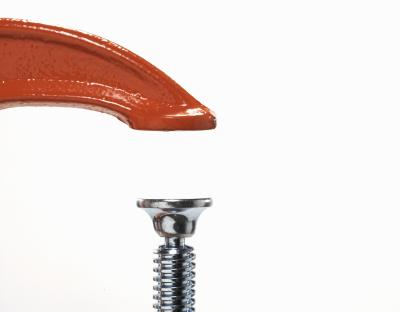
Rear disc brakes feature calipers as hydraulic components to expand and squeeze the brake pads against the surface of the rotors. They are smaller than their front disc brake counterparts. When replacing pads, rotors or both, you must compress the caliper pistons to make room for the new, thicker brake parts. While some vehicles feature calipers that can be compressed with simple tools, others are not so easy. Always refer to a repair manual for your specific vehicle to determine which kind you have or you can damage the calipers.
Hang the caliper with a caliper hook or makeshift hook with a wire coat hanger to the rear suspension once removed. Do not let it hang from the brake hose or you can damage the hose.
Visually inspect the piston on the caliper. If it is a solid piston with grooves, it cannot be compressed with a C-clamp or channel locks. If it is a hollow piston, it can be.
Insert the C-clamp onto the caliper so the top of the clamp is contacting the inside housing and the driving bore of the clamp is inside the hollow piston. If desired, you can use the backing plate of one of the pads to sit on top of the piston. Tighten the C-clamp slowly to compress the piston.
Use a set of large channel locks to accomplish the same task as Step 3 if you don't have a 6-inch C-clamp. Rear calipers are smaller than front calipers and the pistons can usually be compressed much easier than the front.
Use a caliper reset tool to compress the pistons that are solid. (These pistons will have visible notches on the solid piston positioned opposite of one another.) To do so, match up an adapter from the reset tool kit to the notches, then place in the reset tool.
Place the brace bracket of the reset tool on the inside of the outer caliper housing with the adapter and arbor attached to the piston.
Turn the arbor clockwise to compress the piston until it's fully seated inside the bore. Be aware that some vehicles may feature both right and left hand-threaded calipers. This means one side (usually driver's) will feature a clockwise motion to compress the piston, while the other side may feature a counterclockwise motion to compress the piston. While this scenario is rare, it does exist--trying to compress the piston the wrong way can damage it.